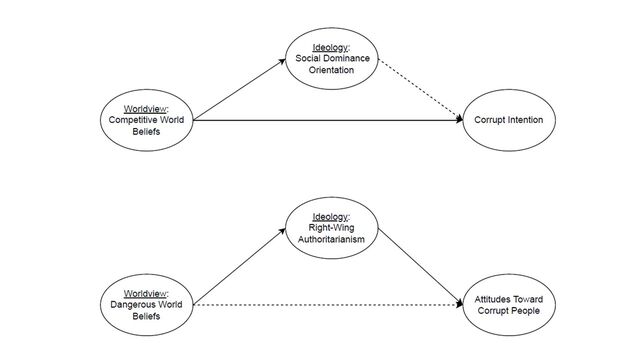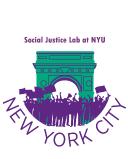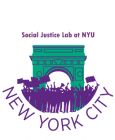Psychology
Corruption Is Not Ideology-Free
Authoritarianism and social dominance predict support for corruption.
Posted November 22, 2022 Reviewed by Devon Frye
By Felipe Vilanova
Whenever we think about corruption, wasted money and political favors come to mind. Whether in Africa, Asia, Europe, or the Americas, we regret the depletion of national wealth (Kaufmann et al., 2009) and the money that could have been used to fund education, health, and public safety. We criticize corrupt individuals, often depicting them as monsters. We wonder who could do such a thing.
Sometimes we begin to feel that corruption is not an ideological matter, but rather a criminal matter, with many people exclaiming that “there is corruption in every party” (The Cable, 2016). We also allow ourselves to think that speaking up against corruption could prevent corrupt behavior (Transparency International, 2015).
Although these common assumptions may be appealing, they are challenged by two results from our research program on the psychology of corruption:
- Not everyone is equally susceptible to corruption, as ideological support for hierarchical social systems predicts corrupt intentions.
- Holding negative attitudes toward corrupt people does not predict corrupt intentions.
Previous Work on the Psychology of Corruption
In an article recently published in the Journal of Personality and Social Psychology (Vilanova et al., 2022), my colleagues Angelo Brandelli Costa, Taciano Lemos Milfont, and I found that corruption bears a curious relationship to psychological factors.
Previous research (Köbis et al., 2015, 2018a, 2018b) indicated that social norms play an important role in increasing and maintaining corruption: The more people believe that corruption is prevalent and socially accepted in society, the more likely they are to engage in corrupt behavior. The idea is that perceptions of high prevalence and acceptance of corruption lead people to engage in moral disengagement (e.g., asking themselves “Who doesn’t take a little off the top?”), thereby justifying corrupt behavior (Köbis et al., 2015).
It might seem obvious that the more people perceive corruption to be common, the more likely they are to engage in corrupt behavior. If everybody does it and benefits from a culture of corruption, why shouldn’t I do it, too?
But the scholars who applied the social-norms framework to corruption took this rationale one step further and showed that this seemingly obvious relationship has important consequences. For example, they used information provided by Transparency International (2017) that there had been a recent decrease in corruption in South Africa to lower rates of corruption even more, especially in the KwaZulu-Natal region. In particular, the researchers (Köbis et al., 2019) put up posters throughout the region highlighting the national reduction in corruption (“Less and less people in KwaZulu-Natal pay bribes”). This simple act proved useful in reducing local corruption rates further.
But what about social contexts in which there are no improvements to be emphasized? According to the Corruption Perception Index 2021 provided by Transparency International (2022), only 25 countries out of 179 (approximately 14 percent) reduced their levels of corruption between 2012 and 2021. Spreading posters would not be a feasible option in most of these countries, so we decided to search for predictors of corruption that could be useful in a variety of settings, such as Brazil.
Corruption in Brazil
My colleagues and I are from Brazil, and we felt that Brazil was a perfect setting in which to investigate the psychology of corruption.
The Lava Jato scandal in 2014 revealed one of the biggest corruption schemes in the world (Netto, 2016), leading to the conviction of 174 people on corruption-related charges and recovering more than 26 billion Brazilian Reais (approximately $5 Billion U.S.). It was discovered that employees of Petrobras, the largest national oil company, were involved in diverting money from the company to pay politicians.
Several civil servants were implicated in the scheme, and one of them, Pedro Barusco, was forced to return 157 million Brazilian reais (approximately $31 million in U.S. dollars), which was only a fraction of what he accepted (Ministério Público Federal, 2022). It is worth noting that this was not an isolated case; all five politicians who governed the state of Rio de Janeiro from 1999 to 2020 were arrested or suspended from office under corruption charges, and one of them, Sergio Cabral, was sentenced to 425 years in jail (G1, 2022).
Interestingly, many politicians who were convicted of corruption had previously railed against it. Although this might seem paradoxical, such contradictory behavior has historical roots in the Brazilian context, especially if we consider what is allegedly the first document written in Brazil: A letter from the clerk Pero Vaz de Caminha sent to the King of Portugal Manuel I in 1500, in which the clerk describes native Brazilians as spiritually corrupt, walking naked through the jungle as if their souls had been consumed by evil. At the bottom of the letter, the clerk asked the king for a favor, begging him to allow his son-in-law, who had been sent to Africa after robbing a church, to return to Portugal (Garschagen, 2015).
Ideologies and Worldviews Underlying Corruption
Because corruption is often linked to politics, and politics is linked to ideological motives, we hypothesized that ideologies might play a role in support for corruption. We focused on two ideological variables that are often explored in social, personality, and political psychology, namely Social Dominance Orientation (SDO) and Right-Wing Authoritarianism (RWA).
SDO is defined broadly as the endorsement of group-based hierarchies in society (Sidanius & Pratto, 1999), and RWA as support for harsh coercive measures, traditional moral values, and submission to authority (Duckitt et al., 2010). It is as if there are two types of authoritarian conservatives: those who do try to reinforce existing hierarchies and actively smash those on the bottom of the social ladder (high SDOs), and those who do not actively seek to smash marginalized groups but rather to maintain the status quo by supporting established authority figures (high RWAs; see Altemeyer, 1998).
According to Duckitt’s (2001) Dual Process Model, there are distinct worldviews that underlie SDO and RWA. High SDO individuals usually view the world as a competitive jungle in which ruthless struggle is necessary to survive. They believe that it is permissible to seek power and status (even through illegal means), and if people do not succeed, it is because they did not put enough effort into it.
On the other hand, high RWAs usually view the world as a dangerous place (Duckitt, 2001). They believe that chaos could erupt at any time, and we should therefore obey established authorities and adopt coercive measures such as capital punishment, as a way of controlling the threat of chaos.
Based on previous studies of ideology and corruption (Ferreira et al., 2022; Rosenblatt, 2012; Tan et al., 2016, 2017), we thought that it would be useful to distinguish between SDO and RWA as antecedents of corrupt intentions and attitudes toward corrupt people. We hypothesized that the psychological processes underlying corrupt intentions and the holding of negative attitudes toward corrupt people would be somewhat independent, and SDO and RWA might explain their co-occurrence.
In six studies, we found that corrupt intentions and attitudes toward corrupt people were indeed relatively independent and predicted by distinct worldviews. The magnitude of the correlation between corrupt intentions and attitudes toward corrupt people was approximately .15 across our studies, indicating a small but significant association.
Those who have intentions to behave corruptly tend to have a slightly more favorable attitude toward corrupt people (and vice versa). Importantly, we observed that corrupt intentions were significantly predicted by SDO but not RWA, whereas attitudes toward corrupt people were significantly predicted by RWA but not SDO.
We also tested the mediation models illustrated in Figure 1 to incorporate perceptions of dangerous and competitive worldviews. We found that SDO did indeed mediate the effect of having a competitive worldview on corrupt intentions and that RWA mediated the effect of having a dangerous worldview on support for corrupt people.

We think that this discovery is a small but useful step in understanding the connections among worldviews, ideologies, and support for corruption. At the same time, it is important to keep in mind that all of our studies were conducted in Brazil, so the results might not apply to very different sociopolitical contexts.
Take-Home Messages
In light of our data, two more take-home messages are worth mentioning.
First, some politicians have proposed instituting harsher punishments for corruption as a way of curbing it. According to our research program, however, instituting more punitive forms of social control might strengthen negative attitudes toward corrupt people, without necessarily affecting corruption rates.
What would be more constructive is to promote ideological opposition to inequality because this might effectively reduce corruption intentions. Consistent with this possibility, other studies have shown that country-level inequality is positively associated with corruption (Jong-Sung & Khagram, 2005). Our research suggests that this association is not restricted to the aggregate level of analysis; the individual-level ideological endorsement of inequality is also positively associated with corrupt intentions.
We should therefore be skeptical of political candidates who claim that will curb corruption while at the same time defending existing inequality as legitimate and desirable. It is important to speak out against corruption, but it also important to keep in mind that not everyone is equally corrupt.
References
Altemeyer, B. (1998). The other “authoritarian personality.” In M. Zanna (Ed.), Advances in experimental social psychology (vol. 30, pp. 47–92). Academic Press.
Duckitt, J. (2001). A Dual-Process Cognitive-Motivational Theory of Ideology and Prejudice. In M.P. Zanna (Ed.), Advances in Experimental Social Psychology (pp.41-113). Academic Press.
Duckitt, J., Bizumic, B., Krauss, S. W., & Heled, E. (2010). A Tripartite Approach to Right-Wing Authoritarianism: The Authoritarianism-Conservatism-Traditionalism Model. Political Psychology, 31(5), 685–715. https://doi.org/10.1111/j.1467-9221.2010.00781.x
Duckitt, J., Wagner, C., du Plessis, I., & Birum, I. (2002). The Psychological Bases of Ideology and Prejudice: Testing a Dual Process Model. Journal of Personality and Social Psychology, 83(1), 75–93. https://doi.org/10.1037/0022-3514.83.1.75
Ferreira, M.C., Fisher, R., Porto, J.B., Pilati, R., & Milfont, T.L. (2012). Unraveling the mystery of Brazilian jeitinho: A cultural exploration of social norms. Personality and Social Psychology Bulletin, 38(3), 331-344. https://doi.org/10.1177/0146167211427148
G1 (May 31, 2022). Cabral é condenado a mais 17 anos de prisão por receber R$78 milhões em propina da Odebrecht. https://g1.globo.com/rj/rio-de-janeiro/noticia/2022/05/31/cabral-e-cond…
Garschagen, B. (2015). Pare de Acreditar no Governo [Stop believing the government]. Editora Record.
Jong-sung, Y., Khagram S. (2005). A Comparative Study of Inequality and Corruption. American Sociological Review, 70(1), 136-157. https://doi.org/10.1177/000312240507000107
Kaufmann D., Kraay A., & Mastruzzi M. (2009). Governance matters VIII: Aggregate and individual governance indicators, 1996–2008. World Bank Policy Research Working Paper nº 4978. http://documents.worldbank.org/curated/pt/598851468149673121/pdf/WPS497…
Köbis, N. C., Iragorri-Carter, D., & Starke, C. (2018a). In I. Kubbe & A. Engelbert (Eds.), Corruption and Norms - Why Informal Rules Matter (pp. 31-52). Palgrave Macmillan. https://doi.org/10.1007/978-3-319-66254-1
Köbis, N. C., Troost, M., Brandt, C. O., & Soraperra, I. (2019). Social norms of corruption in the field - Social nudges on posters can help to reduce bribery. Behavioural Public Policy, 1-28. https://doi.org/doi:10.1017/bpp.2019.37
Köbis, N.C., & Huss, O. (2018b). Ein Atlas zur Unterscheidung von Korruptionsformen. In P. Graeff & S. Wolf (Eds.), Korruptionsbekämpfung vermitteln (pp. 153–181). Springer.
Köbis, N.C., van Prooijen, J., Righetti, F., & Van Lange, P.A.M. (2015). “Who Doesn’t?” – The Impact of Descriptive Norms on Corruption. Plos One, 10(6):e0131830. https://doi.org/10.1371/journal.pone.0131830
Ministério Público Federal (2022). MPF devolve à Petrobras R$ 157 mi desviados por Pedro Barusco. http://www.mpf.mp.br/atuacao-tematica/sci/noticias/noticias-1-1/mpf-dev…
Netto, V. (2016). Lava Jato. Primeira Pessoa.
Rosenblatt, V. (2012). Hierarchies, Power Inequalities, and Organizational Corruption. Journal of Business Ethics, 111, 237-251. https://doi.org/10.1007/s10551-012-1204-y
Sidanius, J., & Pratto, F. (1999). Social dominance: An intergroup theory of social hierarchy and oppression. Cambridge University Press. https://doi.org/10.1017/CBO9781139175043
Tan, X., Liu, L., Huang, Z., & Zheng, W. (2017). Working for the hierarchical system: The role of meritocratic ideology in the endorsement of corruption. Political Psychology, 38(3), 469-479. https://doi.org/10.1111/pops.12341
Tan, X., Liu, L., Zheng, W., & Huang, Z. (2016). Effects of social dominance orientation and right-wing authoritarianism on corrupt intention: The role of moral outrage. International Journal of Psychology, 51(3), 213-219. https://doi.org/10.1002/ijop.12148
The Cable (November 17, 2016). Lai to Govs: There’s corruption in every party, change must begin with us. https://www.thecable.ng/lai-govs-theres-corruption-every-party-change-m…
Transparency International (2017). People and Corruption: Citizens voices from around the world – Global Corruption Barometer. https://www.transparency.org/whatwedo/publication/people_and_corruption… Scholar
Transparency International (2022). Corruption Perceptions Index 2021. https://images.transparencycdn.org/images/CPI2021_Report_EN-web.pdf
Transparency International (August 28, 2015). Speaking up against corruption. https://www.transparency.org/en/news/speaking-up-against-corruption
Vilanova, F., Milfont, T.L., & Costa, A.B. (2022). A dual process social psychological model of corrupt intention and attitudes toward corrupt people. Journal of Personality and Social Psychology, Ahead Online Publication. https://doi.org/10.1037/pspp0000414




